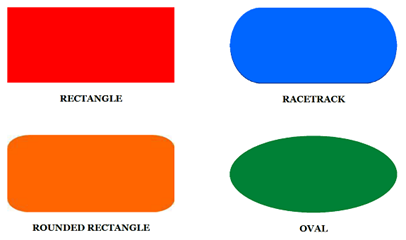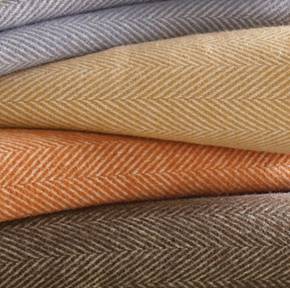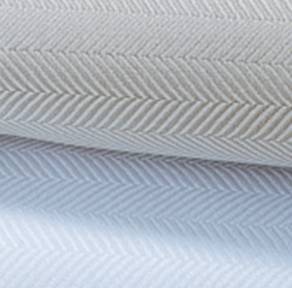Useful Bedding Information
The information on this is page is courtesy of SFERRA Fine Linens
As the term implies, yarn-dyed refers to fabric that uses yarns that are dyed prior to the weaving process. On the other hand, piece-dyed refers to fabric that uses yarns that are un-dyed, or greige (pronounced grey or greyzh), in the weaving process, with the fabric being dyed as pieces at a later time. Yarn-dyed fabrics are those that feature patterns in more than one color. Piece-dyed fabrics are primarily one solid color or tone-on-tone.
Why do some cotton sheets pill?
Pilling occurs when fibers in the fabric break, tangle, and "ball up." The shorter the fibers used in the fabric, the more likely the chance for breakage. The more brittle the fiber, the more breakage will occur. Cotton sheets may pill for a variety of reasons.Generally, the longer the cotton fiber, and the tighter the twist of the yarn, the more stable the fabric will be and the less chance there will be for pilling. You typically want to look for fabric made of long staple cotton, such as Egyptian cotton. However, even the finest of fabrics can pill without proper care, handling, and laundering. Disregarding care instructions may cause fabric to wear and pill. For instance, using chlorine bleach and excessive fabric softener can weaken the fibers, and drying at high heat levels can cause fibers to break. We also recommend using plenty of water during the wash cycle to allow plenty of movement of the fabric and reduce abrasion.
As an individual sleeps, the act of tossing, turning, and moving against weakened fibers creates friction. Over time, this friction can cause these fibers to break (and then, to pill). This is why fitted sheets tend to pill more heavily at the foot of the bed, where the most abrasive and frequent movement occurs.
The best way to prevent pilling is to follow the care instructions. For the care of most fine Linens, we recommend a short wash cycle with gentle detergent. Then, use a low-heat setting during the drying cycle and remove the bedding while still slightly damp. Please take note that even the agitation of the washing machine or the tumbling of the dryer can cause breakage, so never overfill the washer or dryer to avoid additional friction during these cycles. Also, avoid laundering your sheets with other items, such as towels, for the high nap on a Luxury Towel may cause a breakdown of the cotton fibers. To be safe, launder sheets separately.
It should be noted that, because of the differences in construction, Percale weaves have less of a tendency to pill than Sateen weaves. So, if in doubt, go with a Percale weave,
What size tablecloth do you need for your table?
It is easy to calculate the proper size of a tablecloth:
·For a square or oblong table:
oMeasure the length and width of the table.
oDecide on the length of the drop you prefer. The drop is the amount of fabric that hangs down from the top of the table. A typical drop ranges between 10 to 12". If you want your tablecloth to go to the floor, then the drop would usually be 30" (a typical table height), but measure just in case.
oAdd the amount of the drop multiplied by two to both the length and the width of the table.
oFor example: If the table measures 42" wide x 84" long and you want a 12" drop, then the oblong tablecloth should measure 66" (42" width + 24" total drop) x 108" (84" length + 24" total drop).
·For a round table:
oMeasure the diameter of your table.
oDecide on the length of the drop.
oAdd the amount of the drop multiplied by two to the diameter of the table.
oFor example: If the table measures 60" in diameter and you want it to go to the floor with a 30" drop, then the round tablecloth should measure 120" (60" diameter + 60" total drop).
Also remember to allow for shrinkage and add the appropriate amounts to your final calculations. A linen tablecloth (Bennett, Classico, Festival, French Knot) or a cotton tablecloth (Acanthus) may shrink approximately 4% to 8%. For a ringspun polyester tablecloth (Juliet, Orchard) there is no shrinkage.
What is a European return?
A European return is a deep turn-back cuff or hem that runs along the top of a flat sheet and then continues down the side for about fifteen to twenty inches. This decorative hem treatment allows you to fold back the flat sheet over the blanket, coverlet or quilt, giving a well-dressed luxury bed its signature finesse and stylish elegance. The European return is a detail of every SFERRA luxury flat sheet, for even though this feature costs more to produce, it is the hallmark of a well-appointed bed.
What is a flange?
A flange is a classic decorative accent, typically added along three sides of a duvet cover and on all four sides of a pillowsham. A flange extends beyond the dimensions of a duvet or sham, creating a large, elegant flourish. The finest linens use flanges, as well as hemstitching, to create the signature look and soft drape of luxury bedding.
What is a mangle?
The original mangle or "wringer" was a mechanical laundry aid consisting of two rollers in a sturdy frame, connected by cogs and powered by a hand crank and was used to wring water from wet laundry. Today, most mangles are used to press or flatten sheets and other laundry.
What is a Satin Stitch?
A satin stitch or damask stitch is a series of flat stitches that are used to completely cover a section of the background fabric. The stitches are laid side by side, evenly and closely together, creating a large, smooth, satiny area - hence its name. A satin stitch can be used as a decorative stitch or to affix one piece of fabric to another.
What is Appliqué?
Appliqué refers to a needlework technique in which one layer of fabric is placed over another layer of fabric and sewn in place. The term is French in origin and, in this context, means "applied" or "thing that has been applied." Typically, different fabrics are selected for the appliqué to add texture, contrast and style.
What are the selvage, warp and weft in a fabric?
In the weaving process, the selvage (or selvedge) is the self-finished edge. Selvages keep the fabric from unraveling or fraying. The warp yarns are those running lengthwise or vertically, parallel to the selvage. They run the entire length of the fabric. The weft yarns are those running widthwise or horizontally, perpendicular to the selvage. They loop back at the end of each row.
A twill weave is a pattern of diagonal parallel ribs (in contrast with a sateen and plain weave). This is done by passing the weft thread over one or more warp threads and then under two or more warp threads and so on, with a "step" or offset between rows to create the characteristic diagonal pattern. Because of this structure, twills generally drape well.
What is a bed skirt?
A bed skirt is a piece of decorative fabric that runs along the sides and foot of a bed, placed between the mattress and the box spring, reaching down to the floor.A bed skirt covers the sides of the box spring or the space under the bed. A bed skirt also adds a style component to the bed ensemble.
There are two basic types of bed skirts: a one-piece platform bed skirt and a three-panel bed skirt. The platform bedskirt is placed on top of the box spring and drapes over the sides and foot of the bed. The three-panel bed skirt is attached to the box spring using pins.
The benefits of the three-panel bed skirt are:
- It can be easily adjusted to accommodate the height of the bed.
- It can be easily installed without removing the mattress.
Tables are available in a variety of shapes and sizes. An oblong is a rectangle having length greater than width. An oval also has length greater than width, but it has continuous curved sides. Below are images of some common table shapes:

A rectangle, a rounded rectangle, and a racetrack are all oblong and use an oblong tablecloth. A round table that is lengthened with leaves is an oblong, racetrack shaped table.
You may use an oblong tablecloth on an oval shaped table, but the tablecloth will "spire" in the corners with a longer drop towards the floor than on the sides and this is perfectly normal.
What is a herringbone weave?
A herringbone weave is a variation of a twill weave that results in a broken zigzag pattern. It is made up of short parallel rows, slanted in one direction and then another, forming a distinctive "V"-shaped design. A herringbone weave is often made more prominent by the using two colors - one in the weft and another in the warp. The slope or degree of the angle of the diagonal rows can be altered by varying the number, tightness or size of yarns. Because it resembles the skeleton of a herring fish, this woven pattern came to be known as herringbone.
Although similar, a herringbone pattern differs from that of a chevron. To achieve either one, a twill weave is required. However, a chevron is a true zigzag with the direction reversing at the exact point of the change, while a herringbone has a break, and actually jumps one or more places, when the direction changes.
Below are images of the herringbone weave used in Sferra's brushed cotton Celine throw and Sferra's Egyptian cotton Tesoro bed linens:


What is the best way to care for your bed linens?
Caring for your bed linens can be easy if you follow some simple suggestions. In return, you will prolong the life of your bed linens and preserve their beautiful appearance. While SFERRA bed linens are made from natural fibers that generally can be machine-washed at home, please be sure to read the care label on each item for best results.
Washing - Pre-wash your linens before first use. Separate your linens from other items in the wash, especially those containing polyester, which tends to create pilling, and items with heavy zippers, which can damage the fabric. Separate light and dark colors. Avoid overloading the washing machine, which can cause fibers to break down from excessive abrasion and agitation. You can wash most linens in warm water on a gentle cycle with a cold-water rinse, but be sure to check the care label.
Detergent - Use a mild detergent without added bleach, whiteners, or fabric softeners. Do not pour detergent directly on textiles; rather, add it to the water as the wash tub fills or dilute detergent with water, then add linens. Unless linens are very soiled, you only need to use half the recommended amount of detergent.
Bleaching - Chlorine bleach will weaken fibers and cause the fabric to yellow. If white fabrics need bleaching, use only an oxygen-based bleach.
Drying - While line drying outdoors is gentle, safe, and imbues linens with the fresh scent of the outdoors and natural bleaching of the sun, it is not always practical. You can machine dry most linens on low heat, but be sure to check the care label. Shake out damp linens before placing in the dryer. Never use a high heat setting, which will weaken the fibers, damage the fabric, increase shrinkage, and shorten the life of your linens. Remove items from dryer promptly, while still damp, to minimize wrinkles. Smooth and fold, or press with an iron, if desired.
Ironing - Check to make sure your steam iron is clean - mineral deposits could cause brown spotting. Iron linens while still damp. To restore the lustrous face of sateen fabrics, iron on the reverse side. For embroidered linens, iron them on the reverse side atop a towel to preserve the three-dimensional effect of the embroidery. Use a press cloth to protect delicate lace and cutwork.
Shrinkage - All natural fibers will shrink to some extent, but in most instances we generously overcut our products to allow for shrinkage. Do not wash or, especially, dry linens on a hot setting, which is most likely to damage the fabric and intensify shrinkage. Always follow instructions on care label.
Storing Linens - Store bed linens in a cool, dry, well-ventilated area. Linens stored long-term should be wrapped in white cotton, muslin (old pillow cases work well) or acid-free paper. Avoid storing linens in plastic bags or boxes, which can cause permanent yellowing; natural fibers need to breathe. Cedar chests can also yellow or streak fabrics.
How does a flange impact the overall dimensions of a duvet cover or sham?
- Twin Duvet Cover (68x86")
- Full / Queen Duvet Cover (88x92")
- King Duvet Cover (106x92")
- Queen Bed End Duvet Cover (88x50")
- King Bed End Duvet Cover (106x50")
- Boudoir Sham (12x16")
- Standard Sham (21x26")
- King Sham (21x36")
- Continental Sham (26x26")
- Duvet cover:
- Width = inside dimension + 2 times the size of the flange (the flange is on both sides)
- Length = inside dimension + the size of the flange (the flange is only on the bottom)
- Sham:
- Width = inside dimension + 2 times the size of the flange (the flange is on the top and bottom)
- Length = inside dimension + 2 times the size of the flange (the flange is on both sides)